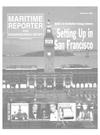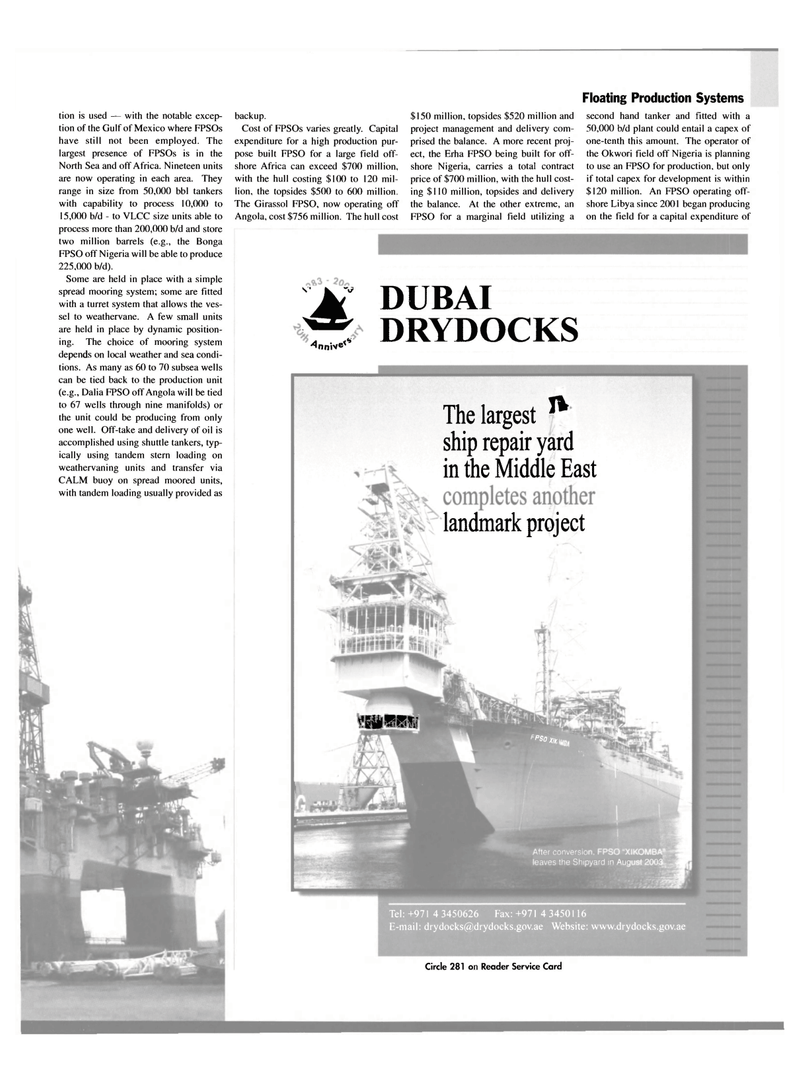
Page 53: of Maritime Reporter Magazine (September 2003)
Read this page in Pdf, Flash or Html5 edition of September 2003 Maritime Reporter Magazine
Floating Production Systems
The largest ^ ship repair yard in the Middle East landmark project mmmi pSO XIK,
Tel: +971 4 3450626 Fax: +971 4 3450116
E-mail: [email protected] Website: www.drydocks.gov.ae
Circle 281 on Reader Service Card backup.
Cost of FPSOs varies greatly. Capital expenditure for a high production pur- pose built FPSO for a large field off- shore Africa can exceed $700 million, with the hull costing $100 to 120 mil- lion, the topsides $500 to 600 million.
The Girassol FPSO, now operating off
Angola, cost $756 million. The hull cost $150 million, topsides $520 million and project management and delivery com- prised the balance. A more recent proj- ect, the Erha FPSO being built for off- shore Nigeria, carries a total contract price of $700 million, with the hull cost- ing $110 million, topsides and delivery the balance. At the other extreme, an
FPSO for a marginal field utilizing a second hand tanker and fitted with a 50,000 b/d plant could entail a capex of one-tenth this amount. The operator of the Okwori field off Nigeria is planning to use an FPSO for production, but only if total capex for development is within $120 million. An FPSO operating off- shore Libya since 2001 began producing on the field for a capital expenditure of tion is used — with the notable excep- tion of the Gulf of Mexico where FPSOs have still not been employed. The largest presence of FPSOs is in the
North Sea and off Africa. Nineteen units are now operating in each area. They range in size from 50,000 bbl tankers with capability to process 10,000 to 15,000 b/d - to VLCC size units able to process more than 200,000 b/d and store two million barrels (e.g., the Bonga
FPSO off Nigeria will be able to produce 225,000 b/d).
Some are held in place with a simple spread mooring system; some are fitted with a turret system that allows the ves- sel to weathervane. A few small units are held in place by dynamic position- ing. The choice of mooring system depends on local weather and sea condi- tions. As many as 60 to 70 subsea wells can be tied back to the production unit (e.g., Dalia FPSO off Angola will be tied to 67 wells through nine manifolds) or the unit could be producing from only one well. Off-take and delivery of oil is accomplished using shuttle tankers, typ- ically using tandem stern loading on weathervaning units and transfer via
CALM buoy on spread moored units, with tandem loading usually provided as
A 4„„Ne<"
DUBAI
DRYDOCKS

 52
52

 54
54
